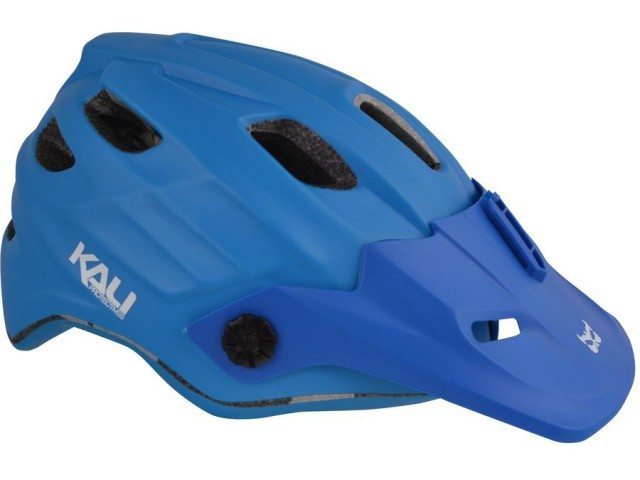
Kali Maya Helmet
Size Tested M/L (58-62 cm)
Blister’s Measured Weight: 392 grams
Stated Features:
- 12 vents
- Adjustable, flexible visor
- Composite Fusion Plus technology
- Integrated light / camera mount
MSRP: $99
Reviewer’s Head Circumference: 59 cm
Days Tested: 10
Test Locations: Park City, UT; Jackson, WY
Intro
The Maya is Kali’s most recent entry in the popular and growing category of helmets that are more substantial and offer more coverage than XC lids, but are still well ventilated. (Such helmets also help one feel more ‘enduro,’ and isn’t that what really matters?)
Kali has been making helmets for a while, but I haven’t always loved their designs. They’ve often seemed confused and overly busy–not the sort of helmet I was willing to display on my noggin, and I’m not usually that picky about these things. But with the Maya, Kali appears to have dragged some organic and sleek design queues out of some previously unknown corner of their studio.
Kali places the Maya at the low end of the price range at $99, and throws in some novel features like an ultra-flexible visor and integrated light/camera mount.
So, is their value proposition compelling?
Construction
At first glance, the Kali Maya’s construction is pretty equivalent to anything I’ve seen from Bell, Giro, or any other brand that offers helmets made with in-molded foam (foam formed directly into the helmet shell). However, a tour through Kali’s website yields a bit more information about how the construction of the Maya is unique.
Kali calls their construction “Composite Fusion Plus.” That means that they use multiple foam densities in the helmet and that foam is formed into a special conical pattern to help dissipate energy.

It all sounds plausible to me, but you should take a look at their website for their explanation of the technology.
Fit
I found the overall fit of the Maya to be oval (like a Giro or TLD) but the sizing is a bit on the large end. So if you are on the edge of their sizing charts, I’d go for the smaller helmet. I have a 59 cm head, and their L/XL helmet (58-62 cm listed fit range) was on the big side for my head. I’m curious to see whether their S/M helmet (52-58 cm) would fit better, but I haven’t yet had a chance to try a S/M on.
Comfort was on par with any Giro helmet I’ve used recently, but not superior to the thickly-padded Troy Lee A1. I didn’t find any pressure points, but it also didn’t have the luxurious feeling of a helmet with thicker pads.
I sought some input on ponytail compatibility from those with longer hair than me. Their response: You can fit a low ponytail below the retention system, but you can’t thread a higher ponytail through it.
Performance
I appreciate that Kali is working to innovate and create safer helmets. The world needs more of that. However, to be pragmatic, I spend most of my time just wearing a helmet around and not crashing in it. To that end, I need a helmet to be comfortable and cool in order for me to choose to wear it over another. (And if I’m being honest, it also needs to be at least decent looking.) Fortunately, the Kali Maya stands up well in all these regards.
Venting and Comfort
The forehead venting on the Kali Maya is excellent, on par with the Giro Xar, and better than the Troy Lee A1. For a helmet offering more coverage than the typical XC lid, that’s impressive.

Additionally, the Maya is a light helmet at 392 g. It feels light, both in hand and on my head. The low weight and airy venting makes it easy to forget that the Kali Maya is on your head during a ride–or during post-ride beers / drives home (consider yourself warned about looking extra cool while wearing the helmet on your drive home). It isn’t noticeably better than a Giro Xar, but I don’t think there is much need for improvement over that helmet for weight.
Sweat Management
The Kali Maya does have a few downsides, though. I found that sweat from my forehead was directed more toward my eyes than with most helmets I’ve tried.
Additionally, while the coverage in the back of the helmet is close to as full as the Troy Lee A1, the back of the helmet sits farther from my head on the Kali than on the TLD A1, and as a result, doesn’t have quite the same comforting and secure feeling. It feels more like a Giro Xar helmet. It might not mean anything, but I definitely spent some time debating whether one was more protective than the other because of it.
Features
Visor
The flexible visor is a clever feature. In a crash, it is supposed to just fold out of the way instead of jamming into the helmet. That seems like a good idea to me.
And in addition to being flexible, the visor is extra long. That length helps to block branches or provide shade from the sun. I liked the extra length and didn’t notice any downsides.
One weird detail, though, that became apparent during an evening ride into the setting sun was that the visor on the blue helmet is actually a little bit translucent, and glows when used to block the sun.
Straps
I found myself a bit bothered by the straps around my ears getting out of place. Fortunately, there are slots on the retention system that can be used to route the straps and hold them in place. It keeps them from getting folded between your head and the retention system. After I routed the straps through the retention system, I was happy and didn’t think about them again.
Overall, while wearing the Maya, I kept finding myself thinking that it was very reminiscent of a Giro Xen helmet or a Fox Flux Helmet. Both are well regarded, and I think the Maya is in very good company there. It is on par with both helmets for fit and weight.
Adjustment
The Maya shares a simple sliding retention system with the Fox Flux helmet. It is functional, but not quite as convenient to adjust as a dial type system. That said, I personally don’t see the retention system adjustment mechanism as a deciding factor between helmets.
Other Features
The built-in camera / light mount that is integrated into the Kali Maya’s visor is clever. It looks clean, it allows for quick attachment of cameras and lights, and, because it is on the visor, it should break away in the case of a crash and prevent the camera or light from torquing the helmet / your head.
I didn’t get a chance to use it for a camera, but I did try it out with a Light and Motion Urban light. The cantilevered weight from the light on the visor was more noticeable than I would have liked—I had to tighten the retention system on the helmet to an uncomfortably tight setting to keep the helmet from rotating forward.
In addition, I found the mount to orient the light too far down (too close to my front tire) to adequately light trails that could be ridden at moderate or high speeds. The visor, at least, didn’t sink with the weight though.
It’s also worth noting that Kali does not offer a MIPS version of this helmet
Bottom Line
The Kali Maya is a solid entry in the all-mountain category. It offers a bit of a different look and is biased toward venting over coverage.
In all categories, I found it to be on par with comparable Giro, Bell, and Fox offerings. If the Maya’s fit and look work for you—and I expect they will for many people—this is a quality helmet at a great price.
